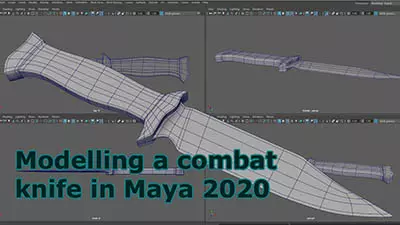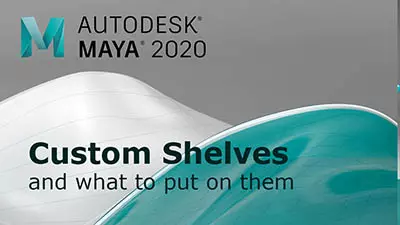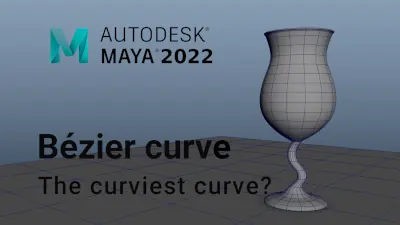Introduction to Maya - Rendering in Arnold
This course will look at the fundamentals of rendering in Arnold. We'll go through the different light types available, cameras, shaders, Arnold's render settings and finally how to split an image into render passes (AOV's), before we then reassemble it i
#
1
11-11-2010
, 02:43 PM
Subscriber
Join Date: Oct 2010
Join Date: Oct 2010
Posts: 4
Overwhelmed noob
I recently discovered SimplyMaya while waiting for my software package to be delivered. I bought the student version which includes :MAYA , 3DS MAX, Motion Builder, MudBox, Sketch Pro
I was using a program called AC3D prior to this. But now I am overwhelmed. I dont know where to start. I have tried following along with tutorials from here and a couple more places. A little confusing though, with the age of the tutorials and the upgrades to the software. Can someone please advise me which one of these programs I should start with and which tutorials to start with. I would very much appreciate some good advice.
Thanks for your help.
#
2
11-11-2010
, 05:42 PM
Registered User
Join Date: May 2009
Join Date: May 2009
Posts: 26
Last edited by fox95871; 14-11-2010 at 07:46 PM.
#
3
11-11-2010
, 06:20 PM
But i learned recently, that i have in some ways shot myself in the foot when it comes to presenting myself as a professional. While i am Very good at what i do. I have as well paid too much attention to one specific area.
The best advice i can give you as a freelance Graphic artist, is to yes, Pick one field you want to know through and through, be it modeling, Animation, Rendering lighting and Shading, Rigging dynamic SFX, ect. Make that choose. Then as well learn a good general overview of the rest also. At least , at the very least develop a descent understanding of Rendering, Lighting, Shading and riging with what every you do choose.
The age of hte Tutorials on Simply maya actually do not hinder you to much. you just need to know the language of the UI as its changed over the years.
What was previously called Polygon in the Polygons Menu set, is now referred to as "Mesh"...like wish what was previously referred to as Nurbs in the menu system, is now referred to as "Surfaces".. unfortunately this isn't a solid change in Maya, meaning its not a complete translation I.E. the Split polygon tool was not changed in name to the "Split Mesh " tool. But after a few hours using the program you'll be able to 'translate' this in your head no problem. Just remember if you hear Nurbs look for Nurbs and or Surfaces, and if you head Polygons look for Polygons and Mesh both ...
a few new tools have been added to modeling, since older versions, Split edge loop tool, offset edge loop tool, some like that, so you wont see them in older tutorials since they are newer functionality. There are also several different methods to achieve the same goal in Maya, you'll just have to experiment over time with which one works best for you. Sadly at this time i cannot tell you of the changes to other aspects of Maya as i am not well enough acquainted with them in older versions to speak to their changes through the years.
The help system in Maya is very intuitive as well, it will tell you everything about any tool, Google is good for this too, you can Google instructions for something you want to learn how to do if you cannot find a video tutorial here to show you.
probably the most important advice i can give you though is Not to give up, and Not feel overwhelmed. Break it into parts. if nothing else, Pick a tool, or two or three tools a day, Create some form of primitive object, and use the tool to see what effects you can have on the primitive with those tools. after a while you're start to get a feel for the program as a whole. Don't get discouraged, I've en working for ten years, with this program and i learn something new at least once a week still. Post your work on here in these forums WE will look at it, and give you our advice and share our knowledge, You've picked the best place to start learning That i assure you. The community here is the nicest and most helpful on the internet.
That being said, I look forward to seeing your work once you start posting. and if you need help feel free to ask any of us.
Welcome to Simply Maya
G-man
#
4
11-11-2010
, 10:20 PM

I just wanted to post something here because I know the feeling you're having.
For multiple apps be a bit careful because learning to navigate the interface itself is probably the most difficult thing to do, it's one of those bumps you have to get over, and imo one of the biggest mistake you can make is start jumping between different apps before you have complete control of all fields in one. So if you've already started with Maya, you should stick with Maya, I made the huge mistake of starting with 3ds max and switching over to Maya before I understood max properly and it really slowed me down.
We've been working on this site for a year now to make the process of actually learning maya easier for people who find us and get over these initial bumps, you can't see it yet though. The new site will hopefully go up next week, one thing we'll launch is something called "Simply Shorts" which will be smaller projects under an hour and similar to the rain, snow and hdr glass we put out a few weeks back where you work on a shorter project and get a nice end result rather than a full ten hour tutorial which is a bit much to stick through for anyone new to maya and it's easy to drop out and give up halfway through.
It's also important to remember that someone who makes a tutorial has spent a lot more time on it than the 7 hours of video you see, I just finished my scene for a tutorial on lighting an exterior and I spent six days on getting just the scene to come out the way I wanted it. And lighting is the field of maya I focus on, so it's not easy for anyone. I think when you see gorgeous images in galleries you rather think that wow I could never do that than that someone put a lot of time and hard work into it.
The thing with Maya is that it does take so long to learn but it tends to go in spikes, you have periods where you feel like you're not getting anywhere followed by periods where you progress really fast so the learning curve is very steep. Also remember that you don't have to start with modeling but you could do something else first if you struggle because modeling is time consuming and with the risk of getting shot as there's a lot of good modelers on this forum I personally find it slightly dull. I've only started to build proper models in the past few months, before that I'd download other peoples (we have a resources section on this site where you can find a lot, other cg sites have them as well) and practice lighting and texturing that way if you'd rather take that route. I think that building a good model is very difficult and require huge efforts whereas if you use someone else's model and shade and light it you'll get good results a lot faster which might inspire you not to give up because you'll see that it's actually possible to make something nice without being a master at everything.
So if you stick with us for a week or two we should have updated training which will make this site so much better for new users. For learning the basics I think books are by far the best, tutorials should be used for workflows and learning techniques you can apply to your own work and get results, not to go through every single node in Maya. I've always liked Sybex, everything they've published that I've read has been great. Introduction to Maya and Mastering Maya are booth really god books to have on the side of tutorials, they contain some good text tuts as well. And remember F1 for the Maya help files, they're so useful if you get stuck on something

#
5
12-11-2010
, 02:26 PM
Lifetime Member
Join Date: Apr 2007
Join Date: Apr 2007
Posts: 73
my 2c worth
I dropped off the Radar for a few years after I left college... as I no longer had access to Maya. And I had a headache from trying to work it out all by myself... I then found a student copy of Maya 2008 on a suspect disk that did the rounds at College. And fell back in love with it. I like to think I'm intelligent but after six months of intense personal study I still felt- and feel today like a complete noob every time I work on something. I couldnt even come to terms with how to Model, and texture, and rig, and animate, and light, and render a SIMPLE scene.
 I put Maya aside for awhile and fiddled with other things on that disk like Bryce 5, 3ds Max, Mudbox, Zbrush, Poser....
I put Maya aside for awhile and fiddled with other things on that disk like Bryce 5, 3ds Max, Mudbox, Zbrush, Poser....I would like now to firmly echo Miss_Novas advice NOT to do that. New interfaces and slightly different tool sets... Learn one and learn it well and you'll enjoy it alot more.
When I got an E-Mail out of the blue from here about the summer sale my gloomy experience with 3D Animation had 3 point lighting installed.
My advice to someone Brand New or close to, is to purchase the Apache tutorial from here, it's bloody long but I learnt more in the first hour of that tute than I had in all the time I'd wasted prior. (Once I worked out what the "Rwee key" was) - First of many Life altering moments that guys lessons have given me.
Many of the people here make me feel unworthy with the stuff they post... or just mention off hand while giving simple advice in the Newbie forum... but everyone seems to have also felt like they were banging their heads against a wall at times, and they go out of their way to prevent that misery happening to others..
GL fella

#
6
12-11-2010
, 03:28 PM
Subscriber
Join Date: Oct 2010
Join Date: Oct 2010
Posts: 4
So I took a suggestion and imported one of my models from AC3D into Maya lastnight. I was going to work on lighting. But two of the textures do not render. I thought maybe it was because they were in PNG format while the others were in JPG. I converted the files and imported into Maya again. Still no luck. Any ideas?
BTW, here is a sample of one of my latest works on Deviantart.
sample
#
7
14-11-2010
, 06:53 PM
Registered User
Join Date: May 2009
Join Date: May 2009
Posts: 26
https://blitzbasic.com/Products/blitz3d.php
Last edited by fox95871; 14-11-2010 at 07:54 PM.
#
8
14-11-2010
, 11:11 PM
If you do get the shader up but just not the textures I can't really tell you what's wrong but the best way to find out is to run render diagnostics in the script editor. If you open the render view window and click on the icon to the far right maya should tell you why your textures don't show up. It's a good idea to run render diagnostics on any scene because you'll pick up some useful tips on how to optimize your scene and sometimes it might have problems you didn't notice.
I also really like that apache tutorial, though it is 19 hours of solid modeling
 Another great tutorial of similar caliber is the Ferrari, it's also done in maya 6 but the techniques remain exactly the same mental ray just got a bit speedier. Cartoon modeling is less detailed though so if you get stuck on realistic organics model the Haunted House. I'm also a fan of Jason Edwards, his work is great and he pays attention to a lot of things other people do not in modeling. His Chef Ramsay tutorial is great and it's newer so would work well if you'd struggle getting around the interface.
Another great tutorial of similar caliber is the Ferrari, it's also done in maya 6 but the techniques remain exactly the same mental ray just got a bit speedier. Cartoon modeling is less detailed though so if you get stuck on realistic organics model the Haunted House. I'm also a fan of Jason Edwards, his work is great and he pays attention to a lot of things other people do not in modeling. His Chef Ramsay tutorial is great and it's newer so would work well if you'd struggle getting around the interface.
Posting Rules Forum Rules
Similar Threads
A very very big noob
by lizardfolk in forum Maya Basics & Newbie Lounge replies 15 on 01-01-2010
Noob Here With a Question About 3d Paint Tool
by Underscore678 in forum Maya Basics & Newbie Lounge replies 2 on 29-10-2007
Nov/Dec - Noob - Kartzan
by Kartzan in forum Previous Challenges (Archives) replies 4 on 08-11-2005
i want to partisipate ichallenge of somn a noob
by fire_master in forum Maya Basics & Newbie Lounge replies 3 on 18-02-2004
Another dragon - by noob
by Sil-Valeor in forum Work In Progress replies 9 on 29-04-2003
Topics
Free Courses
Full Courses
VFX News
How computer animation was used 30 years ago to make a Roger Rabbit short
On 2022-07-18 14:30:13
Sneak peek at Houdini 19.5
On 2022-07-18 14:17:59
VFX Breakdown The Man Who Fell To Earth
On 2022-07-15 13:14:36
Resident Evil - Teaser Trailer
On 2022-05-13 13:52:25
New cloud modeling nodes for Bifrost
On 2022-05-02 20:24:13
MPC Showreel 2022
On 2022-04-13 16:02:13









